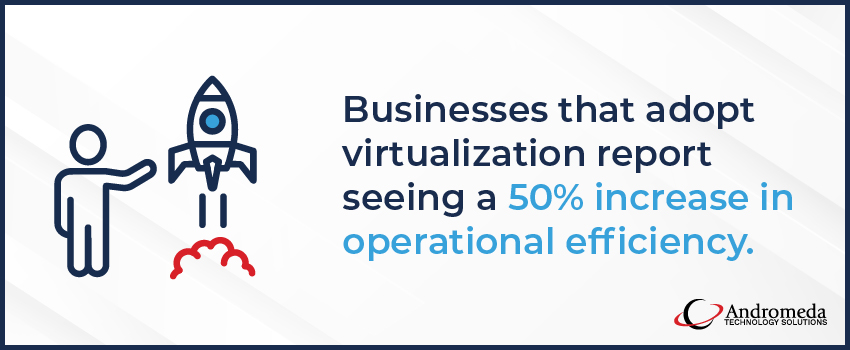
Network Virtualization: How To Improve Network Performance
Today's businesses need innovative solutions to stay competitive, agile, and efficient – especially as reliance on cloud-based applications and systems grows. One solution that has gained ground over the past few years is network virtualization, with the virtualization software market set to reach an estimated $163 billion by 2027.[1]
This transformative technology has revolutionized how organizations manage their networks, providing a host of benefits that align with the evolving demands of modern enterprises. In this blog, we'll break down how network virtualization benefits businesses of all sizes and how you can get started with a virtualization platform for improved network security, performance, and cost savings.
What Is Network Virtualization?
Network virtualization is the process of creating a virtualized network architecture that abstracts the underlying physical network resources – such as routers, switches, and firewalls – and delivers network functions without physical hardware. It enables businesses to create multiple virtual networks that can operate independently and securely on the same physical infrastructure.
How Does Network Virtualization Work?
Network virtualization abstracts an organization's physical network infrastructure and creates virtualized network overlays on top of it. Here's a high-level overview of how it typically works:
Virtual Switching
Software-based virtual switches (vSwitch) are deployed on each physical server or network node and operate at the network stack's data link layer (Layer 2). A vSwitch handles the switching of network traffic between virtual machines (VMs) running on the server.
Virtual Network Abstraction
A network virtualization controller creates and manages virtualized networks. It abstracts the underlying hardware and communicates with the vSwitches to configure the virtual networks.
Overlay Networks
Virtual networks exist as overlay networks that run on top of the network's underlying physical infrastructure. An overlay network encapsulates traffic within packets specific to that network, enabling multiple networks to coexist on the same infrastructure without interfering with each other.
Network Address Translation (NAT)
Network virtualization typically uses NAT techniques to map virtual network addresses to physical ones, allowing VMs to communicate with external networks and vice versa. NAT helps maintain isolation between multiple networks and improves security by hiding the internal network structure.
Packet Forwarding
With network virtualization, any packet that needs to move between virtual machines on different servers or network nodes is encapsulated within a packet specific to the virtual network before being forwarded.
Network Policies
Network virtualization allows administrators to enforce network and security policies at the virtual network level. Each virtual network can have its own policies, access controls, and quality of service (QoS) settings for fine-grained control over traffic.

Why Is Network Virtualization Important for Businesses?
Network virtualization is integral for businesses looking to improve network performance and efficiency. By abstracting physical IT elements such as computing, network, and storage away from hardware, businesses can automatically deploy new workloads and network resources where they're needed most. This is especially important in the telecom industry, where traditional service providers struggle to quickly transform their networks and operations to keep up with technological innovation.
Here are a few ways a network virtualization platform can help businesses stay ahead of changing technology needs:
Application and Service Mobility
With network virtualization, IT teams can easily move applications and services between servers or data centers without having to reconfigure the network infrastructure. Virtualized networks maintain connectivity and service continuity, which is likely why 66% of companies that adopt virtualization report improved agility.[2]
Facilitates Cloud Computing
Network virtualization forms the foundation for agile, scalable cloud solutions by providing the flexibility, scalability, and isolation needed in dynamic cloud environments. Because virtual networks can be dynamically created, modified, or removed as the demand for virtual resources fluctuates, businesses can quickly scale network services to meet the needs of different applications and workloads.
Multi-Tenancy Support
Network virtualization enables businesses to create separate networks for each department, team, or client. This multi-tenancy support allows them to provide secure and isolated network environments for different entities to ensure privacy, confidentiality, and customized network services.
Benefits of Network Virtualization
Network virtualization is an important tool for businesses of any size, as it provides several benefits over traditional network architectures. Some of the biggest benefits include:
Improved Efficiency
Businesses report seeing a 50% increase in operational efficiency after adopting virtualization.[2] Network virtualization software allows multiple networks to share the same infrastructure, resulting in more efficient use of network switches, routers, and other equipment. Additionally, automating manual processes frees IT staff to focus on other business goals for greater operational efficiency overall.
Better Performance
Network virtualization software intelligently distributes traffic across available paths and resources based on predefined rules or algorithms. This load balancing and traffic optimization eliminates traffic bottlenecks, allowing businesses to enjoy faster, more consistent network performance.
Cost Savings
Abstracting physical networks into software-based virtualized networks helps organizations reduce their reliance on hardware and eliminate the need to purchase additional equipment for new networks or applications.
Centralized Control
Network virtualization provides a single point of control, reducing complexity across multiple networks and simplifying management for network administrators.
Greater Flexibility
With network virtualization software, businesses easily adjust their network functionality to meet changing business needs. This makes it easier for businesses to respond to market changes faster by expanding their networks and deploying new applications and services without disrupting existing operations.
Increased Security
Along with simplifying security policy deployment and management, network virtualization improves security by isolating different virtual networks from each other. This isolation helps contain potential data breaches within individual networks, minimizing the impact on the overall business network.

Types of Network Virtualization
Network virtualization is traditionally either external or internal.
- External virtualization spans several locations, connecting multiple physical networks into a single virtualized infrastructure for seamless communication and connectivity.
- Internal virtualization, also known as a virtual local area network (VLAN), divides a physical network into multiple logical network segments on a single virtualized server.
Common types of network virtualization include:
Virtual Private Networks (VPNs)
VPNs provide virtualized connections over a shared or public network to secure sensitive data transfer between geographically distributed locations or remote users via encrypted tunnels.
Virtual Routing and Forwarding (VRF)
VRFs function as an independent routing instance to allow for network segmentation and isolation. VRF virtualization is often used by service providers to support multi-tenancy or to segregate different departments or customers within an organization.
Software-Defined Networking (SDN)
SDN introduces a centralized controller that manages the behavior and configuration of network devices. SDNs provide businesses with centralized management, policy enforcement, and dynamic network provisioning by abstracting a network's underlying components and providing a software-based control plane.
Harness the Power of Network Virtualization With Andromeda
With more businesses embracing remote and hybrid working models, providing employees with fast, secure access to company resources should be a top priority. Luckily, the right network virtualization platform can help you keep your work-from-anywhere teams connected and productive without compromising security.
If you're ready to simplify and optimize your hybrid work environments, Andromeda Technology Solutions can help. We provide virtual desktop infrastructure (VDI) services to help you reduce costs and optimize your network while providing remote access through a central server. Get in touch today to learn more.
Sources:
Keep Your Business Safe, Secure, and Running
We’ll take a proactive approach to your manufacturing IT – and help your business blast off.



